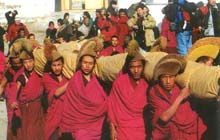
 Every Tibetan family struggled to afford the honor of sending a family member to a monastery. This indeed was no small sacrifice since the continuing upkeep of the monks was the responsibility of their respective families. To give some idea of the popularity of this religious mission, in the early twentieth century approximately one fifth of all Tibetan men were monks. Though there were also nunneries, their numbers were not as large.
Every Tibetan family struggled to afford the honor of sending a family member to a monastery. This indeed was no small sacrifice since the continuing upkeep of the monks was the responsibility of their respective families. To give some idea of the popularity of this religious mission, in the early twentieth century approximately one fifth of all Tibetan men were monks. Though there were also nunneries, their numbers were not as large.
When a young boy, aged six or seven, was sent off to the monastery, it was not certain that his occupation would be scholastic. Depending on his strengths, the young initiate might be assigned to become a soldier, cook or clerk within the monastic administration. Only an intellectual and spiritual elite was privileged to participate in the 25 year scholastic apprenticeship necessary to graduate to geshe examinations.
Daily Routine
The monastery begins its day at 5am when all the monks assemble at the prayer hall for morning worship. Two hours later they return to their respective houses to enjoy a breakfast of Tibetan bread and butter tea (a mixture of black tea, milk, butter and salt). The rest of their morning until lunch break at 12.30pm is taken up with monastic classes. In the afternoon, monks attend individual lessons given in their separate houses. After a dinner of soup and rice at 6pm, they attend Buddhist scripture classes until 9pm. Senior monks will attend philosophical debates instead.
Primary Education
After establishing a foundation in reading, writing and arithmetic, progressively graded classes provide explanations of elemental Buddhist Teachings or Sutras, as well as teaching in various techniques of recitation. These classes are graded and will occupy the student until he is sixteen to eighteen years of age.
When deemed ready, the student will start to take part in debates, a crucial discipline. Supervised by seniors, the monks divide into small groups and take turns asking questions and debating various topics. Debating skills are highly valued as instruments to sharpen the mind as well as for preparing monks to answer questions from students in the future.
Having mastered rhetoric and debate, the monk must sit exams in logic. Once this is done, he is ready to embark on a more advanced course of study.
Advanced Study
This is comprised of the following six elements:
1) Perfection of Wisdom ( Prajnya parramita )
Based on "The Jewel of Realization", a 4th century text, the pupil spends 6 years considering such subjects as the nature of nirvana, deep levels of meditation and the wish for enlightenment.
2) The Middle Way ( Madhyamika )
Spending four years studying a collection of texts dating from the 3rd to the 7th century, the student goes deeper into the analysis of the quality of emptiness and the ephemeral properties of such emotions as joy, illness and jealousy.
3) Higher Knowledge ( Abhidharma )
Written by Master Vasubandhu in 350CE, "The Treasure House of Higher Knoweldge" is the text that leads students to investigate the role and creation of karma, the nature of bardo (the intermediate state between death and rebirth), the constituents of time and space and the destruction of the world. These themes demand two years of monastic study.
4) Vowed Morality ( Vinaya )
A further two years are spent considering the nature of monastic vows, both in terms of their benefits and the attendant loss of freedom.
5) Buddhist Logic ( Pramana )
This is a study that occurs in periodic intervals throughout the 15 years of advanced study. It examines logical reasoning per se as well as the validity of many arguments at the root of the Buddhist faith.
6) The Steps to Buddhahood (Lam Rim)
Written by the founder of the Gelug sect, this 15th century text, prepares the student for the ritualistic meditation required along the path to enlightenment.
Having finished this study, the monk will qualify as a medium scholar geshe . After a further 7 years of study of degree text, and passing its associate exams, he will qualify as a highly learned scholar, or top-level geshe . In all, by this time, he will have spent 32 years in study.